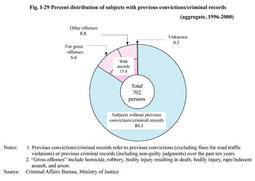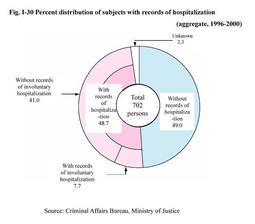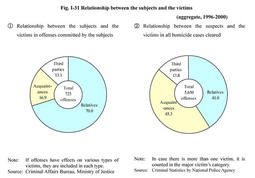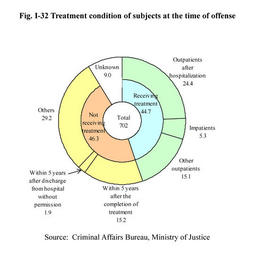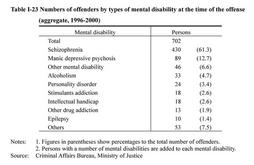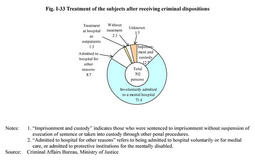| Previous Next Index Image Index Year Selection | |
|
|
3. Characteristics of mentally disabled offenders---focusing on homicide offenders--- The investigation by the Criminal Affairs Bureau of the Ministry of Justice shows that, during the last five years from 1996 to 2000, suspects who were treated as insane persons and those who were treated as quasi-insane persons by public prosecutors offices in criminal dispositions for homicide (excluding preparation for homicide and involvement in suicide for the purpose of this section) as well as those who were found not-guilty on the grounds of being insane or given a reduced sentence on the grounds of being quasi-insane by first instance amounted to a total of 702. (These 702 persons are referred to as "subjects" in this section. )
(1)Previous convictions/criminal records and previous records of hospitalization Fig. I-29 shows the percent distribution of subjects with previous convictions/criminal records. 108 subjects had previous convictions/criminal records, of which 46 had previous convictions for gross offenses (i. e. homicide, arson, robbery, rape/indecent assault, bodily injury resulting in death, bodily injury, and attempt thereof). Fig. I-30 shows the percent distribution of subjects with records of hospitalization before committing an offense. 342 subjects had records of hospitalization before committing an offense, of which 54 had experienced being involuntarily admitted to a mental hospital. Fig. I-29 Percent distribution of subjects with previous convictions/criminal records (aggregate, 1996-2000) Fig. I-30 Percent distribution of subjects with records of hospitalization (aggregate, 1996-2000) (2)Relationship between the subjects and the victims and the treatment condition at the time of the offense Fig. I-31 [1] shows the relationship between the subjects and the victims in the offenses committed by the subjects. Victims are divided into relatives, acquaintances and third parties. Fig. I-31 [2] shows in the same manner the relationship between the suspects and the victims in all homicide cases cleared from 1996 to 2000. Comparison between these two figures indicates that relatives had a larger share in offenses committed by the subjects than in the case of all homicide cases, while third parties had almost the same share of the total number of victims. Fig. I-31 Relationship between the subjects and the victims (aggregate, 1996-2000) Fig. I-32 shows the treatment condition of subjects at the time of offenses.Among the subjects, 314 were receiving treatment at the time of offenses, of which 37 were in the hospital, 171 were receiving treatment as outpatients after hospitalization and 106 were just receiving treatment as outpatients. 325 were not receiving treatment at the time of offenses, of which 120 committed offenses within five years of receiving treatment in hospital or from having been discharged from hospital without permission, and 205 had received no treatment within five years before they committed offenses. Table I-23 shows the number of subjects by type of mental disability at the time of offense. Fig. I-32 Treatment condition of subjects at the time of offense Table I-23 Numbers of offenders by types of mental disability at the time of the offense (aggregate, 1996-2000) (3)Treatment after receiving criminal dispositions Fig. I-33 shows the treatment of the subjects after receiving criminal dispositions. 89 were sentenced to imprisonment without suspension of execution of sentence or taken into custody. Among those who were not prosecuted, granted suspension of execution of the sentence or found not-guilty, 501 were involuntarily admitted to a mental hospital. Combined with 61 subjects who were admitted to hospitals for other reasons and 9 subjects who received treatment at hospital as outpatients, a total of 571 subjects received treatment after being released. Fig. I-33 Treatment of the subjects after receiving criminal dispositions |
